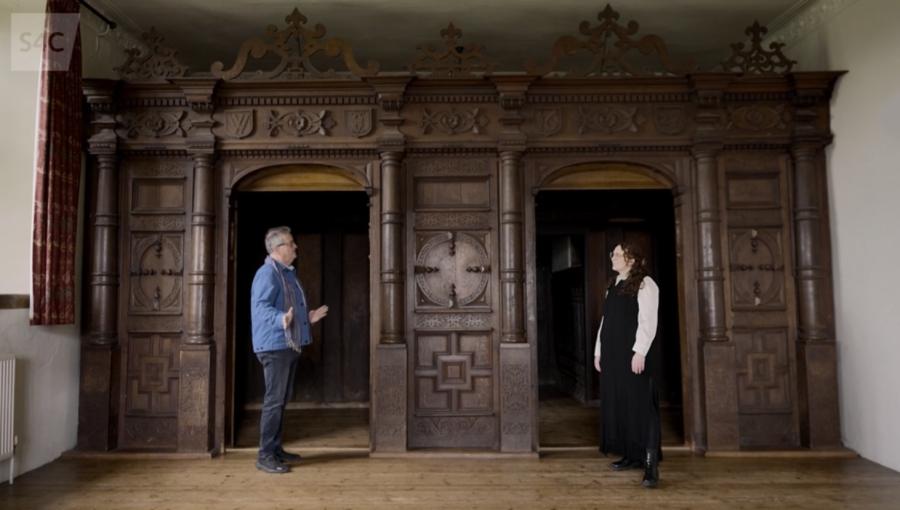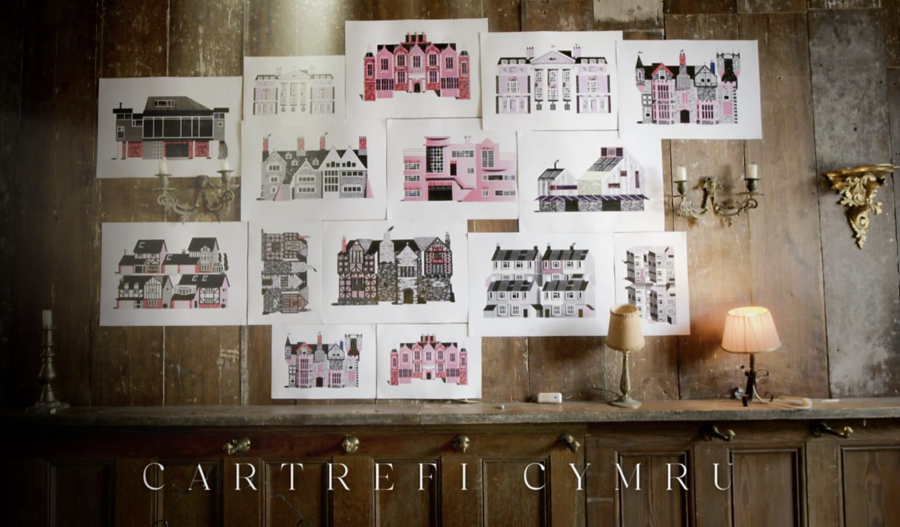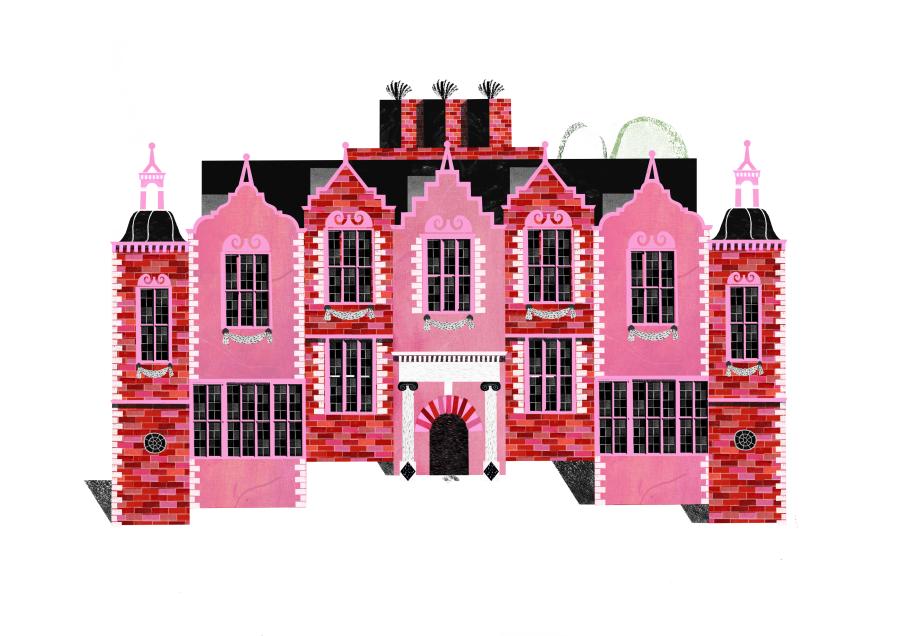New S4C series 'Cartrefi Cymru' explores the history and evolution of houses in Wales
ISWE Doctoral Researcher Bethan Scorey tells us about her involvement in ‘Cartrefi Cymru’, a brand-new Welsh language television series tracing the history and evolution of houses in Wales from the Tudor period to the present day. The programme is currently being broadcast on S4C, and episodes are available to watch on S4C Clic and BBC iPlayer.
Tell us about the series ‘Cartrefi Cymru’?
Cartrefi Cymru is a brand-new series made by production company BOOM Cymru. It explores the history and evolution of houses in Wales over ten episodes, starting in the Tudor period in the first episode and moving all the way up to contemporary houses in the final episode, looking at architectural and social developments which impacted on houses at all levels of society. The series is presented by Aled Samuel, who has presented countless programmes about houses and heritage in Wales, including ’04 Wal’, ‘Cartrefi Cefn Gwlad Cymru’, ‘100 Lle’, ‘Gerddi Cymru’, and ‘Dan Do’. Every half-hour episode features three houses, and includes a chat with the owners or occupiers of a house from the period under discussion to hear about their experiences of living in an old house.
What is your role on the show, Bethan?
I’m the on-screen building historian: I appear alongside Aled in the first half of each episode to provide an overview of the main architectural developments of the period under discussion and to explore the main house, before Aled goes on to see two more houses in the second half. I’ve also been working behind the scenes to help find the houses to feature in the show and to research the main house ahead of filming.
Have you done any television work before or is this a new venture for you?
Television is completely new territory for me, and while it was a bit daunting, in my role as on-screen historian I’m always in conversation with Aled rather than presenting to camera. Live interpretation of historic buildings is something that I am very well practiced in having worked as a Museum Assistant at St Fagans National Museum of History for just shy of ten years. In this role I was stationed in one of the re-erected buildings and tasked with interpreting it for visitors, which is something that I enjoyed immensely, especially helping people to resonate with and connect with buildings. The years at St Fagans definitely prepared me for this new television role, especially because the re-erected buildings at St Fagans have such a broad date range, from Iron Age roundhouses to a 1940s prefab.
What have you enjoyed most about the process?
I’ve absolutely loved spending so much time in historic houses all over Wales. It’s always a privilege to get to spend the day in these buildings, and to have them all to yourself is the icing on the cake! Throughout my career, I’ve had the pleasure of spending a lot of time in historic buildings, from working in St Fagans National Museum of History to my master’s course in Building History when we were always out an about on field trips. Having spent so much time in the library writing my doctoral thesis recently, it was wonderful to be back in these historical settings. It’s also been wonderful getting to know Aled and the BOOM Cymru team, who all love old buildings as much as I do; they have made so many wonderful shows together that you’d struggle to find a building in Wales that none of them have been to!

Has your doctoral research fed into this role?
The first two episodes of the series - which have already been broadcast - focused on the Tudor and Stuart periods, and as the subject of my doctoral research is the Elizabethan manor house St Fagans Castle, I felt very comfortable filming these. As well as generally celebrating historic houses in Wales, the series conveys the important role country houses and associated houses have played in the history of Wales, and in this respect it definitely aligns with ISWE’s interests. Cartrefi Cymru and ISWE also share the common goal of emphasising the architectural and social significance of these houses. We began the series at Llancaiach Fawr, which epitomises gentry houses in the Tudor period; however, between filming and broadcasting the episode, Caerphilly Borough Council have announced their intention to close the house to the public, something which ISWE strongly objects to.
What was your favourite house to film in?
I’ve enjoyed all the filming days for various reasons, but there are a few that stand out. The third episode explored Georgian houses in Wales, and the main house was Llanerchaeron just outside Aberaeron, designed by architect John Nash and built in 1790. This is a fascinating house which looks deceptively simple on the outside, when in fact there are a lot of exciting shapes going on inside, as though Nash started with a cube and carved out the rooms. But the main house in the eighth episode on the 1960s and 1970s was my absolute favourite, because it’s a house with so much colour and personality - as you would expect from this period - and the interests of the owners are embedded in the design; I really look forward to that one being broadcast in the new year.
What are you most proud of about the series?
One of the things I believe makes the series stand out is that we are looking at the evolution of houses from the Tudor period to the present day over ten chronological episodes. Each episode is a snapshot of a particular period, but hopefully the series as a whole will help viewers to understand why buildings evolved over time and why certain architectural styles fell in and out of fashion over the centuries.
What have been the main challenges?
Generally speaking, the main challenge for me has been speaking as concisely as possible. This makes a change from academic writing where I am able to delve deep into every argument and elaborate on every point, although it has been extremely valuable to develop both skillsets. More specifically, the final episodes on contemporary houses presented a bit of a challenge, as it is difficult to summarise what characterises houses in the present without hindsight to guide you. However, the main contemporary house featured in the episode is wonderful and my undergraduate degree in architecture has given me an understanding of the design process behind a contemporary building.


You also did the illustrations for the opening titles?
Yes, I also illustrate historic buildings so it was lovely to be asked to contribute to the opening titles, which was another first for me! I was invited to ‘invent’ a building to represent each episode, so each is an amalgamation of different buildings from the period under discussion. But that was just the first step, as the production team then took these illustrations and displayed them in a rustic setting to create the really lovely, romantic opening titles.
So far we’ve seen the Tudor, Stuart and Georgian periods under consideration, but what can we expect from the fourth episode on Wednesday?
In the fourth episode we’ll be looking at houses in the Victorian period. The main house under consideration will be Treberfydd House in Llangasty in the Bannau Brycheiniog National Park. As you’d expect from a Victorian country house, it’s eclectic and filled to the brim with different materials, patterns and colours, so it makes a very interesting comparison with the Classical, more restrained Llanerchaeron that we saw in the previous episode.
You mentioned that the series will be broadcast in two halves. What can we expect from the second half of the series?
The first half features several country or gentry houses, but we move into the twentieth century in the second half of the series, when of course fewer country houses were being erected; if anything, country houses were being demolished! As a result, the series shifts to focus on mass housing and the social developments behind these, which adds another dimension to the show.
Cartrefi Cymru is currently being broadcast on S4C every Wednesday at 8.25pm. Episodes are available to watch on S4C Clic and BBC iPlayer. The second half of the series will be broadcast in early 2025.
